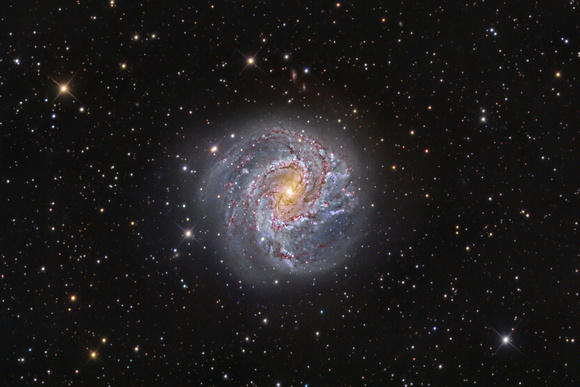Imaged Remotely
12.5" RCOS
STL-11000 with AO
HaLRGB 300min(4x15, 8x15, 4x15, 4x15, 4x15)
All Binned 1x1
Darks Applied
Astrodon RGB Filters
Paramount Equatorial Mount
Fair Dinkum Skies,
Pingelly AustraliaData registered and dark subtracted in Maxim DL, image assembled from Ha, L, R, G, and B frames in Photoshop CS3/FITS Liberator.
Each individual channel was pre-processed in PixInsight LE prior to processing each channel separately in CS3. This allowed for individualized treatment of each channel according to it's particular needs.
FITS data was initially stretched and noise reduced in PixInsight LE, then transfered to CS3 via FITS Liberator by a linear conversion (no stretch involved). The luminance data was then processed, contrast adjusted, and sharpened in CS3. The color data was balanced, saturated, and star size reduced (particularly the red channel) to allow good color merge in CS3 and then layered onto the luminance data as a color layer.
Color adjustments and final sharpening of the luminance data were executed prior to merging the layers and the Ha was then added to the LRGB image to accentuate the Ha regions in the final HaRGB image shown here.
Bottom line - each channel was processed according to it's individual needs.
Thank you - you know who you are - for allowing me to use this marvelous equipment for a night. I just wish I could afford this kind of setup on a permanent basis.
M83 (NGC 5236) is an
intermediate spiral galaxy approximately 15 million light-years away in the
constellation Hydra. Messier 83 stretches over 40 000 light-years, making it roughly 2.5 times smaller than our own Milky Way. However, in some respects, Messier 83 is quite similar to our own galaxy. Both the Milky Way and Messier 83 possess a bar across their galactic nucleus, the dense spherical conglomeration of stars seen at the centre of the galaxies.
The core of M83 itself is bright
at x-ray energies, showing a high concentration of neutron stars and black holes left from an intense burst of star formation.
It is one of the closest and brightest
barred spiral galaxies in the sky, making it visible with
binoculars. Six
Supernovae (SN 1923A, SN 1945B, SN 1950B, SN 1957D, and SN 1983N) have been observed in M83.
March 5, 2009 and Reworked June 6, 2009


